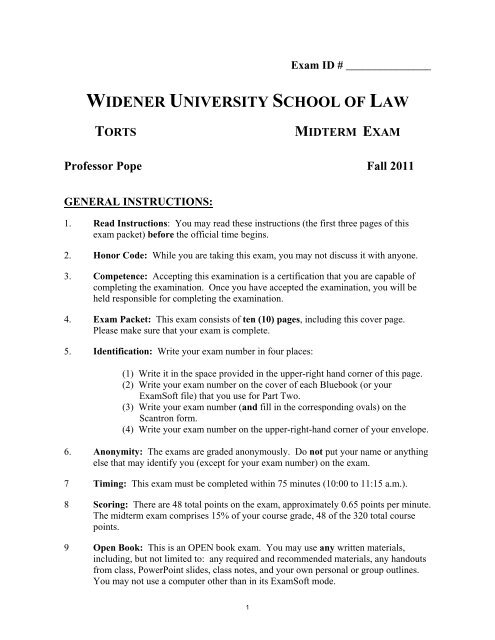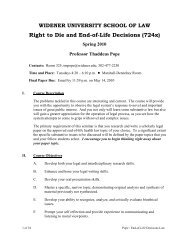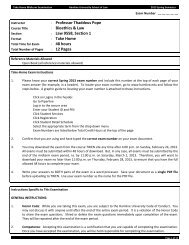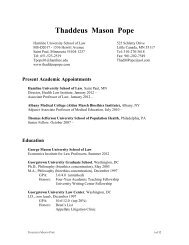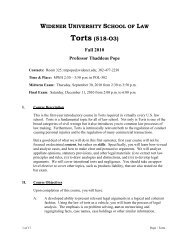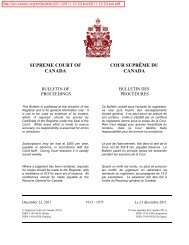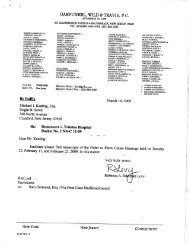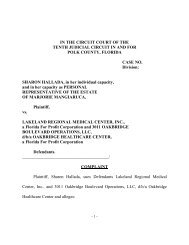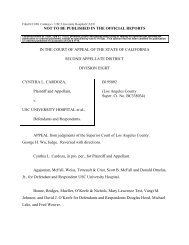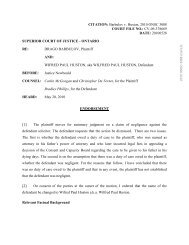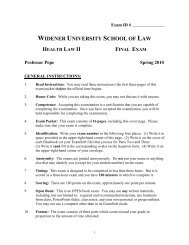Midterm Exam (Fall 2011) - Thaddeus Pope
Midterm Exam (Fall 2011) - Thaddeus Pope
Midterm Exam (Fall 2011) - Thaddeus Pope
You also want an ePaper? Increase the reach of your titles
YUMPU automatically turns print PDFs into web optimized ePapers that Google loves.
<strong>Exam</strong> ID # _______________<br />
WIDENER UNIVERSITY SCHOOL OF LAW<br />
TORTS<br />
MIDTERM EXAM<br />
Professor <strong>Pope</strong> <strong>Fall</strong> <strong>2011</strong><br />
GENERAL INSTRUCTIONS:<br />
1. Read Instructions: You may read these instructions (the first three pages of this<br />
exam packet) before the official time begins.<br />
2. Honor Code: While you are taking this exam, you may not discuss it with anyone.<br />
3. Competence: Accepting this examination is a certification that you are capable of<br />
completing the examination. Once you have accepted the examination, you will be<br />
held responsible for completing the examination.<br />
4. <strong>Exam</strong> Packet: This exam consists of ten (10) pages, including this cover page.<br />
Please make sure that your exam is complete.<br />
5. Identification: Write your exam number in four places:<br />
(1) Write it in the space provided in the upper-right hand corner of this page.<br />
(2) Write your exam number on the cover of each Bluebook (or your<br />
<strong>Exam</strong>Soft file) that you use for Part Two.<br />
(3) Write your exam number (and fill in the corresponding ovals) on the<br />
Scantron form.<br />
(4) Write your exam number on the upper-right-hand corner of your envelope.<br />
6. Anonymity: The exams are graded anonymously. Do not put your name or anything<br />
else that may identify you (except for your exam number) on the exam.<br />
7 Timing: This exam must be completed within 75 minutes (10:00 to 11:15 a.m.).<br />
8 Scoring: There are 48 total points on the exam, approximately 0.65 points per minute.<br />
The midterm exam comprises 15% of your course grade, 48 of the 320 total course<br />
points.<br />
9 Open Book: This is an OPEN book exam. You may use any written materials,<br />
including, but not limited to: any required and recommended materials, any handouts<br />
from class, PowerPoint slides, class notes, and your own personal or group outlines.<br />
You may not use a computer other than in its <strong>Exam</strong>Soft mode.<br />
1
10 Format: The exam consists of two parts which count toward your grade in proportion<br />
to the amount of time allocated.<br />
PART ONE comprises 10 multiple choice questions worth two points each,<br />
for a combined total of 20 points. The suggested total completion time is 30<br />
minutes (3 minutes each).<br />
PART TWO comprises one essay question worth 28 points. The suggested<br />
completion time is 45 minutes.<br />
11 Grading: All exams will receive a raw score from zero to 48. The raw score is<br />
meaningful only relative to the raw score of other students in the class. Your course<br />
letter grade is computed by summing the midterm, final, and quiz scores. But for<br />
informational purposes only, your midterm raw score will be converted into a scaled<br />
score and letter grade, based on the class curve. The applicable law school mandatory<br />
curve in this class permits a maximum average grade of 2.30 to 2.75. At least 10% of<br />
the students must receive grades of B+ or above, and at least 10% of the students must<br />
receive grades of D+ or below. I will post an explanatory memo and a model answer<br />
to TWEN a few weeks after the exam.<br />
12 Special Instructions: Instructions specific to each exam section are printed<br />
immediately below.<br />
SPECIAL INSTRUCTIONS FOR PART ONE:<br />
1. Format: This Part contains 10 multiple choice questions, worth two points each, for a<br />
combined total of 20 points. This part has a suggested completion time of 30 minutes.<br />
Please note that the questions vary in both length and complexity. You might answer<br />
some in 20 seconds and others in three minutes.<br />
2. Identification: Write your exam number: (a) on the first page of this exam booklet.<br />
and (b) on the Scantron form. Please also (c) fill in the ovals corresponding to your<br />
exam number.<br />
3. Fill the Oval on the Scantron: For each question, fill in the oval on the Scantron<br />
with a number 2 pencil corresponding to the best answer choice.<br />
4. Ambiguity: If (and only if) you believe the question is ambiguous, such that there is<br />
not one obviously best answer, neatly explain why in a separately marked section of<br />
your Bluebook or <strong>Exam</strong>Soft file. Your objection must (i) identify the ambiguity or<br />
problem in the question and (ii) reveal what your answer would be for all possible<br />
resolutions of the ambiguity. I do not expect this to be necessary.<br />
2
SPECIAL INSTRUCTIONS FOR PART TWO:<br />
1. Submission: Write your essay answers in your Bluebook examination booklets or<br />
<strong>Exam</strong>Soft file. I will not read any material which appears only on scrap paper.<br />
2. Legibility: Write legibly. I will do my best to read your handwriting, but must<br />
disregard (and not give you points for) writing that is too small to read or otherwise<br />
illegible. I am serious; write neatly.<br />
3. Outlining Your Answer: I strongly encourage you to use at least one-fourth of the<br />
allotted time per question to outline your answers on scrap paper before beginning to<br />
write in your exam booklet or <strong>Exam</strong>Soft file. Do this because you will be graded not<br />
only on the substance of your answer but also on its clarity and conciseness. In other<br />
words, organization, precision, and brevity count. If you run out of insightful things to<br />
say about the issues raised by the exam question, stop writing until you think of<br />
something. Tedious repetition, regurgitations of law unrelated to the facts, or<br />
rambling about irrelevant issues will negatively affect your grade.<br />
4. Answer Format: This is important. Use headings and subheadings. Use short<br />
single-idea paragraphs, and leave a blank line between paragraphs. Do not completely<br />
fill the page with text. Leave white space between sections and paragraphs.<br />
5. Answer Content: Address all relevant issues that arise from and are implicated by<br />
the fact pattern and that are responsive to the “call” of the question. Do not just<br />
summarize all the facts or all the legal principles relevant to an issue. Instead, apply<br />
the law you see relevant to the facts you see relevant. Take the issues that you identify<br />
and organize them into a coherent structure. Then, within that structure, examine<br />
issues and argue for a conclusion.<br />
6. Citing Cases: You are welcome but not required to cite cases. While it is sometimes<br />
helpful to the reader and a way to economize on words, do not cite case names as a<br />
complete substitute for legal analysis. For example, do not write: “Plaintiff should be<br />
able to recover under A v. B.” Why? What is the rule in that case? What are the facts<br />
in the instant case that satisfy that rule?<br />
7. Cross-Referencing: You may reference your own previous analysis (e.g. B’s claim<br />
against C is identical to A’s claim against C, because __.” But be very clear and<br />
precise what you are referencing. As in contract interpretation, ambiguity is construed<br />
against the drafter.<br />
8. Balanced Argument: Facts rarely perfectly fit rules of law. So, recognize the key<br />
weaknesses in your position and make the argument on the other side.<br />
9. Additional Facts: If you think that an exam question fairly raises an issue but cannot<br />
be answered without additional facts, state clearly those facts (reasonably implied by,<br />
suggested by, or at least consistent with, the fact pattern) that you believe to be<br />
necessary to answer the question. Do not invent facts out of whole cloth.<br />
3
Do NOT turn this page<br />
until the proctor signals<br />
4
PART ONE<br />
10 questions worth two points each = 20/48 points<br />
Suggested Time = three minutes each = 30/75 minutes<br />
1. An ice cream truck driver was driving at a safe speed on Route 202. From the other<br />
direction a tractor trailer came around a curve and was confronted with a very slowmoving<br />
red car just in front of him. To avoid colliding with the car, the tractor trailer<br />
pulled to the left and crossed the center lane, where he bore down on the ice cream<br />
truck driver who was approaching from the opposite direction. The tractor trailer<br />
driver did not yield and there were other vehicles (including the red car) to the ice<br />
cream driver’s left. The ice cream truck driver’s only option was to turn to the right,<br />
onto another person’s land. His truck caused damage to the landowner’s property.<br />
Which of the following best describes the ice cream truck driver’s liability to the<br />
landowner?<br />
A. Ice cream truck driver is liable for nominal damages only<br />
B. Ice cream truck driver is liable for damage to the land<br />
C. Ice cream truck driver is liable for nothing because he reacted to an emergency<br />
situation that he did not create<br />
D. Ice cream truck is liable for nothing because the incident was not his fault and he<br />
acted in a reasonable and responsible manner<br />
2. A pet owner left his dog in his yard when he went to work. The dog’s constant<br />
barking greatly annoyed his neighbor. When the pet owner came home that evening<br />
he found the body of his beloved pet in the yard with blood around its nose and mouth.<br />
The pet owner was very upset because the dog had been his pet for many years. A<br />
subsequent investigation revealed that the neighbor had given the dog a treat with rat<br />
poison in it, because she could not stand the barking.<br />
If the pet owner brings an action against the neighbor to recover for IIED, he will<br />
likely:<br />
A. Prevail, but only so long as he suffered physical injury from his distress<br />
B. Prevail, if the neighbor was aware that it was very likely that the pet owner would<br />
suffer severe emotional distress<br />
C. Not prevail, unless the neighbor desired to cause the pet owner severe emotional<br />
distress<br />
D. Not prevail, because the neighbor did not kill the dog in the presence of the pet<br />
owner<br />
5
3. A motorist was driving along a narrow, winding road when his car ran out of gas.<br />
Because the road (like many in Pennsylvania) had no shoulders, the motorist pushed<br />
his car onto the driveway of a landowner. Finding nobody at the house, the motorist<br />
started walking toward a gas station he had passed two miles back. While the motorist<br />
was gone, the landowner returned and found the car in his driveway with its front<br />
wheels in the flower garden. While the landowner had never posted any “No<br />
Trespassing” signs, he wanted the car off his property right away. The car was<br />
unlocked. So, the landowner released the parking brake, carefully pushed the car back<br />
onto the road, and reset the brake. Before the motorist could return a truck sideswiped<br />
the car, damaging it.<br />
Can the motorist recover against the landowner for damage to his car?<br />
A. Yes, because the landowner had not posted any “No Trespassing” signs on his<br />
property<br />
B. Yes, because the motorist was privileged to leave his car there<br />
C. No, because the motorist damaged the landowner’s property<br />
D. No, because the landowner reasonably believed that he had a right to remove the<br />
car from his property<br />
4. A patient sought psychiatric treatment from a psychiatrist. During the treatment, the<br />
psychiatrist, unbeknownst to the patient, videotaped her. No sound recording was<br />
made of the sessions. The psychiatrist was conducting a research study, unrelated to<br />
the patient’s treatment, on “body language” and planned to use the tapes in that<br />
research project. The patient later learned that the psychiatrist had been taping their<br />
sessions and brought an action for battery.<br />
If the patient does not prevail, it will probably be because:<br />
A. She did not suffer any physical injury as a result of the psychiatrist’s actions<br />
B. The psychiatrist had consent because the patient agreed to psychiatric treatment<br />
C. She did not suffer an offensive contact<br />
D. The psychiatrist intended that his actions would foster medical research<br />
6
5. At the season finale of AMERICAN IDOL the judges announced both the first runnerup<br />
and the winner. As the winner prepared to make some acceptance remarks, the first<br />
runner-up loudly shouted: “That bitch won only because she slept with all the judges.”<br />
The winner immediately slapped the runner-up in the face.<br />
If the runner-up brings an action for battery against the winner, who will<br />
prevail?<br />
A. Winner, because she was provoked by the runner-up’s comment<br />
B. Winner, because a reasonable person would have slapped the runner-up under the<br />
circumstances<br />
C. Runner-up, because the winner intentionally caused an offensive contact<br />
D. Runner-up, unless the winner’s slap was a only a spur-of-the-moment response to<br />
the runner-up’s comments<br />
6. Developer owned a 15-acre tract of land that was covered with trees. His first step in<br />
development of the land for a new WALMART was removal of the trees. The<br />
developer’s neighbor knew that developer planned to remove the trees from the<br />
property. The day before development was to start the neighbor went onto the land<br />
and cut down a number of the trees for firewood. The developer brought an<br />
appropriate action against the neighbor for damages.<br />
The developer will most likely:<br />
A. Recover only nominal damages, because the value of the land was not diminished<br />
B. Recover nominal damages and the value (if any) of the trees removed<br />
C. Not recover, because removal of the trees saved him money<br />
D. Not recover, because the value of the land was not diminished by the removal of<br />
the trees<br />
7
7. Kasey heard a strange noise one night. She took a handgun from her bed-side stand<br />
and walked around inspecting her house. Kasey’s neighbor, Erie, also heard the same<br />
strange noise. He walked out of his house and onto Kasey’s front lawn, thinking that<br />
the sound came from her house. He stood silently on the lawn, listening. When Kasey<br />
was near the front door, she stepped on her cat, startling both her and the cat. This<br />
caused Kasey to drop the gun. It fell onto the floor and discharged. The bullet went<br />
through the front door and hit Erie.<br />
If Erie sues Kasey on a battery theory, he will:<br />
A. Prevail, because handguns are very dangerous<br />
B. Prevail, because Kasey is legally responsible for the actions of her cat<br />
C. Lose, because the firing of the gun was not a volitional act<br />
D. Lose, because Erie was a trespasser<br />
8. Chrissie was furious at her father for sending her to Rutgers Law instead of to<br />
Widener Law (where the cool professors are). Chrissie instituted proceedings to have<br />
her father committed to a psychiatric facility. Chrissie testified falsely that her father<br />
was addicted to prescription medications and that he had abused her and other family<br />
members when they were younger. The judge did not believe Chrissie, found the<br />
father competent, and dismissed the commitment petition. As a result of the legal<br />
proceedings and Chrissie’s false testimony, the father suffered severe distress and<br />
anxiety.<br />
If the father sues Chrissie for IIED, who is likely to prevail?<br />
A. Father, because Chrissie acted with knowledge of the falsity or reckless disregard<br />
as to the truth or falsity of her allegations<br />
B. Father, unless he did not suffer physical injury<br />
C. Chrissie, because the father was never actually confined or involuntarily<br />
committed<br />
D. Chrissie, because she acted under authority of law<br />
8
9. A law student went to a new comfortable, attractive coffee shop to study Torts. But<br />
just as the law student was entering, an art student stopped her saying, “This is a place<br />
of beauty. We don’t want disgusting law students here.” The law was student angered<br />
by this remark and said, “Get out of my way.” The art student said “No. Make me.”<br />
The law student took out her full-sized umbrella, intending to frighten the art student,<br />
and swung it near her head. But the umbrella broke and a large piece flew off, striking<br />
the art student.<br />
If the art student sues the law student for battery, she most likely will:<br />
A. Prevail, because she was struck by the umbrella<br />
B. Prevail, unless she intended to provoke the law student<br />
C. Not prevail, because the negligence of the umbrella manufacturer was the real<br />
cause of the injury<br />
D. Not prevail, if a reasonable person would not have been angered by what the<br />
art student had said<br />
10. Professor <strong>Pope</strong> was sitting on a bench in the Rittenhouse Square Park. Suddenly, a<br />
disheveled man approached him, grabbed Professor <strong>Pope</strong>’s hands tightly, and began to<br />
pray. The man claimed that he was a faith healer and that he could “heal” Professor<br />
<strong>Pope</strong>’s various problems. In actuality, the man was an outpatient at a nearby mental<br />
health facility. At trial, the jury determined that the man knew Professor <strong>Pope</strong> had not<br />
consented to having his hands grasped, but that the man truly believed he had the<br />
ability to heal Professor <strong>Pope</strong>.<br />
If the man asserts a defense that he was mentally disabled, this defense is:<br />
A. Not valid, because he was only an outpatient and not completely committed<br />
B. Not valid, because he still had the requisite state of mind for battery<br />
C. Valid, because mentally disabled patients cannot be held responsible for their<br />
tortuous actions<br />
D. Valid, because the man really did believe he was a faith healer<br />
9
PART TWO<br />
1 essay question worth 28 points (of 48 total exam points)<br />
Suggested time = 45 minutes (of 75 total exam minutes)<br />
Dakshesh was employed as a laborer by the City of Wilmington, Delaware. On September<br />
12, <strong>2011</strong>, Dakshesh was sent to the Wilmington City Park and instructed to plant a row of<br />
saplings along the property line between the City Park and the neighboring property, owned<br />
by Pythia. While the city supplied the saplings, Dakshesh had to provide his own tools and<br />
materials. Dakshesh went to the City Park and began to dig holes for the saplings along what<br />
he believed was the city’s side of the dividing line between the properties. He was relying on<br />
stakes that were erroneously placed by the City of Wilmington on Pythia’s property.<br />
After he had dug several holes, Pythia came out of her house and advised Dakshesh that he<br />
was digging on her property. She ordered him to leave. Dakshesh became enraged and<br />
swung his shovel at Pythia, narrowly missing her head. Frightened that Dakshesh would<br />
strike her, Pythia jumped backwards. But she tripped and broke her ankle. She then got up<br />
and went inside.<br />
Hobbling, a few minutes later, Pythia returned from her house holding her Beretta 92FS<br />
semiautomatic pistol. Pointing the gun at Dakshesh, who was still packing up his equipment,<br />
Pythia shouted, “Get the fuck off my property now, asshole!” Dakshesh was pretty scared<br />
and immediately jumped in his truck and drove away.<br />
Identify and assess all the intentional tort causes of action:<br />
1. that Pythia might reasonably assert against Dakshesh<br />
2. that Dakshesh might reasonably assert against Pythia<br />
10
<strong>Exam</strong> ID _____________<br />
<strong>Pope</strong> – Torts: <strong>Fall</strong> <strong>2011</strong> <strong>Midterm</strong> <strong>Exam</strong> Scoring Sheet<br />
Multiple Choice Questions (2 points each)<br />
Question Correct Distractors Question Correct Distractors<br />
1 B C (6), D (4) A (2) 6 B A (4), D (1)<br />
2 B C (11), D (8), A (5) 7 C D (6), A (1)<br />
3 B D (12) 8 A B (3), C (2)<br />
4 C B (6), D (3), A (2) 9 A B (2)<br />
5 C none 10 B D (3)<br />
Score Distribution<br />
Explanations<br />
Mean = 16 of 20<br />
Highest = 20 of 20<br />
Q1 The driver swerved to avoid an accident. He had a private necessity privilege to trespass land but<br />
must still pay actual damages. There are no facts to support a public necessity privilege.<br />
Q2 A, C, and D are too demanding. Intent for IIED can be satisfied not only by subjective desire but<br />
also by either recklessness or defendant’s knowledge to substantial certainty that her conduct will<br />
cause SED.<br />
Q3 Defendant’s defense of land privilege was negated by plaintiff’s private necessity privilege.<br />
Q4 B is wrong because the taping was outside the scope of plaintiff’s consent. D is wrong because<br />
noble motives do not matter. A is too demanding.<br />
Q5 N/A<br />
Q6 B is better than A, because you need not actually determine the value of any trespass to land. B says<br />
that “if” there is any such value, then that is recoverable too.<br />
Q7 The facts do not support a defendant’s reasonable belief of danger the supports shooting someone<br />
outside the house. Moreover, the defendant clearly did not “intend” to shoot. It was a non-volitional<br />
accident.<br />
Q8 B is too demanding. Physical injury is not required.<br />
Q9 B is wrong because “provoked” intentional torts are still intentional torts.<br />
Q10 Even if the defendant thought he was a “faith healer,” the jury found he knew his conduct would be<br />
offensive.<br />
Essay Question<br />
(28 points)<br />
NOTE: This problem was adapted from and materially amends essay question 4 on the February <strong>2011</strong><br />
New York State bar exam.<br />
PYTHIA v. DAKSHESH<br />
Trespass to Land<br />
Voluntariness<br />
Entry<br />
Damages<br />
D made a deliberate and voluntary choice to go to the land that happened to be P’s. He<br />
went there to do his job. His mistake (even though blameless) does not negate this<br />
intent.<br />
D actually did enter on P’s land (both himself and his equipment). Plus, he remained on<br />
the land after he was asked to leave.<br />
While P need not demonstrate damages, she can recover for the costs to fill the holes that<br />
D dug on her land. (Some students argued trespass to chattel and conversion for the<br />
holes. But land is not a chattel.)<br />
1<br />
1<br />
½
<strong>Exam</strong> ID _____________<br />
Necessity<br />
Justification<br />
Assault<br />
D has no public necessity or justification privilege. There was no emergency situation to<br />
which he had to react.<br />
--<br />
Intent D was angered by P’s remarks. D apparently wanted either revenge or to scare P away. 2<br />
In any case, D knew with substantial certainty that swinging a shovel would put a ½<br />
reasonable person in apprehension of imminent contact. (A general intent argument is<br />
prudent because of the thin basis from which to infer specific intent.)<br />
Apprehension P had apprehension of imminent HC as demonstrated by her jumping backwards. 2<br />
I- HOC P’s apprehension was reasonable given the size and distance of the shovel. ½<br />
Battery<br />
Intent There is nothing to indicate D’s intent to cause a HOC. But the intent for the assault can 2<br />
transfer since it was caused by the same shovel swing as above. (Some students argued<br />
an intended battery and transferred that intent to the assault. That is acceptable, as it is<br />
equally consistent with the facts.)<br />
HOC The shovel swing caused P to fall and break her ankle. 2<br />
DAKSHESH v. PYTHIA<br />
Assault<br />
Intent<br />
Apprehension<br />
I-HOC<br />
Defense of land<br />
P wanted to scare D off her property because she was angry both about the trespass and<br />
about her ankle. Her words confirm that she wanted him to be afraid and to leave. (It is<br />
not sufficient to just restate the facts. You must explain why/how these facts support the<br />
inference about P’s motive and desire.)<br />
P knew with substantial certainty that pointing a gun would cause IHOC.<br />
D was scared. He immediately jumped in his truck and drove away without his<br />
equipment.<br />
A reasonable person would be in apprehension of imminent HOC if an angry person<br />
pointed a gun at them while shouting profanities.<br />
Basis D was on P’s land. P asked nicely. But D turned mean. 2<br />
Scope P only threatened force. So this was proportionate, calibrated force. 2<br />
On the other hand, D was already packing up, so even that amount of force was<br />
2<br />
inappropriate. Of course, P may (reasonably) not have recognized that he was packing<br />
up and preparing to leave.<br />
Trespass to chattel<br />
Intent While there is no evidence on direct intent, the same gun pointing that constitutes an<br />
assault also deprived D of his equipment. The intent can transfer. (This is a key reason<br />
why D would not allege conversion. It is also unclear that the deprivation would be<br />
substantial enough to constitute conversion in any case.)<br />
2<br />
But if the assault was privileged (defense land), then intent cannot transfer. It is unclear 2<br />
that the privilege applies directly because causing trespass to chattel it does not further<br />
the privilege.<br />
Deprivation By scaring D away, P caused D to abandon his equipment. He was deprived of it until 1 ½<br />
(presumably) it was later recovered.<br />
TOTAL 28<br />
Score Distribution<br />
Mean = 16.625 of 28<br />
Highest = 22.5 of 28<br />
2<br />
½<br />
2<br />
½
<strong>Pope</strong>: Torts <strong>Midterm</strong> <strong>Exam</strong> Grades (<strong>Fall</strong> <strong>2011</strong>)<br />
ID MC (20) ESSAY (28) TOTAL (48) GRADE<br />
296809 12 14 26 D+<br />
313693 14 18 32 B-<br />
625042 14 12 26 D+<br />
627918 18 15.5 33.5 B<br />
662330 14 19 33 B-<br />
668831 14 14.5 28.5 C<br />
684320 16 16.5 32.5 B-<br />
689231 16 19.5 35.5 B+<br />
701951 16 17 33 B-<br />
702573 12 14 26 D+<br />
703988 20 18.5 38.5 A<br />
704148 18 17 35 B+<br />
704671 14 20 34 B<br />
704679 14 21 35 B+<br />
704868 16 17 33 B-<br />
704962 18 17.5 35.5 B+<br />
704973 16 11.5 27.5 C-<br />
708710 18 14.5 32.5 B-<br />
723379 18 18 36 B+<br />
724050 14 22.5 36.5 A-<br />
754838 18 17.5 35.5 B+<br />
764762 12 13 25 D+<br />
764928 20 16.5 36.5 A-<br />
766485 14 13 27 C-<br />
769159 18 10 28 C<br />
803945 16 17.5 33.5 B<br />
807856 14 21.5 35.5 B+<br />
824021 16 18 34 B<br />
824733 14 17 31 C+<br />
828555 18 12 30 C+<br />
829998 20 15.5 35.5 B+<br />
843384 18 19.5 37.5 A-<br />
843800 16 19 35 B+<br />
864941 16 15 31 C+<br />
866873 16 12 28 C<br />
883522 18 21 39 A<br />
883540 16 19.5 35.5 B+<br />
883874 14 20 34 B<br />
884849 18 16.5 34.5 B<br />
942026 14 13.5 27.5 C-<br />
AVERAGE 16 16.625 32.35 B-<br />
The Student Handbook requires that “the mean grade in each section of a first year required . . . must fall<br />
within the 2.300 to 2.750 range.” It also requires that “at least 10% of the students must receive grades of<br />
B+ or above, and at least 10% of the students must receive grades of D+ or below.”


